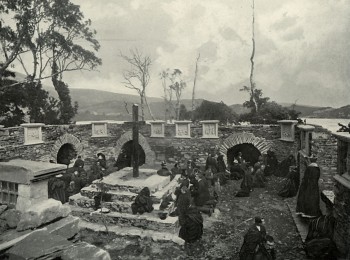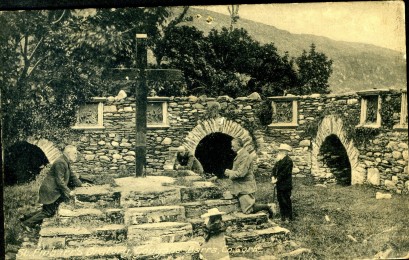
Kieran’s Our City, Our Town Article,
Cork Independent, 15 October 2011
In the Footsteps of St. Finbarre (Part 270)
The Reworking of Memories
On my perch next to the main set of cells in Gougane Barra, many come looking for the old money tree. For many years, the remains of an old cross stood alongside the tree. This may have the cross that Fr Patrick Hurley, the Parish Priest commissioned in the early 1900s. The cross, which was made of yew from Ardmore, was erected by Mr. Buckley of Youghal and had on it in three languages – English, Latin and Irish, on an enamelled plate, the following inscription, “Here stood in the sixth century the cell of St Finbar, first Bishop of Cork”. This cross for many years in the twentieth century also had coins stuck in it and was replaced in recent years by the present cross.
Fr Hurley in the first decade of the 1900s also pursued some work on Father Denis O’Mahony’s tomb, which he notes in 1892 in his article in the Journal of the Cork Historical and Archaeological Society, as very much neglected. On taking off the old flagstone covering it, he discovered an inscription on it (and was nearly obliterated) of a beautifully-carved limestone cross, from a model of one in St Mary’s Church, Youghal, County Cork. He got the stone inscribed with a cross, chalice and host. Portions of the coffin, made of black oak, in the tomb were opened. The bones were carefully collected and placed in an oak case with a suitable inscription.
On the pilgrimage island Fr Hurley commissioned a memorial in memory of J.J. Callanan, poet, author of the poem Gougane Barra, and noting on the inscription “Born in Cork AD 1795. Died in Lisbon, where he is buried, the 15th September 1829 – RIP”. Jeremiah Joseph Callanan (1795–1829) was an Irish poet born in County Cork, Ireland. Callanan studied for Catholic priesthood at Maynooth College, and afterwards law at Trinity College, Dublin, where he won two prizes for his poems. Afterwards, he found employment teaching briefly at a school in his hometown of Cork. Callanan also contributed translations of Irish verse to Blackwood’s Magazine, which was run by another promoter of Irish literature, Dr William Maginn. For four years up to 1827 Callanan spent much of his time going around Cork and the south west of Munster collecting old ballads and legends and having them translated and published. One of his most famous translations was that of an Irish poem on Gougane Barra (translated to Gougane Barra). In 1827 he travelled to Lisbon to work as a tutor in 1827. He died in Lisbon in 1829 as he was preparing to return to Ireland.
In an article in the Irish Independent in 1905, Fr Hurley reveals his strategy for social improvement amongst the people of the surrounding region. He noted that on his arrival he found the Irish language on the point of going. He discouraged this, and in the schools, and from the altar he impressed on the local people “the beauty of their own language [Irish]”. Fr Hurley’s work was part of a larger revival in Gaelic culture in Ireland at that time. In 1893 Douglas Hyde played the leading role in the foundation of the Gaelic League. The purpose of the league was to revive the disappearing culture and traditions, and its work stimulated considerable popular enthusiasm for the study of the Irish language. In particular the Catholic Church played a large role in attending League meetings and promoting the Irish language. This is apparent in the myriad of articles, which record their contribution in the Cork context at least in the Cork Examiner from the early years of the 1900s.
In addition in an attempt to encourage the use of the Irish language in schools, Fr Hurley made the acquaintance of Rev Richard O’Daly, a priest of a diocese of Goulbourne, Australia, who made his studies at the College of Propaganda, Rome. He had an opportunity there of studying languages from his contacts with students from all nations, and subsequently travelled through Europe, where he acquired a knowledge of nearly every European language. Born in Australia, but with parents from the Ballingeary area, he wished to learn the Irish language. He began learning at the Gaelic League classes in London, where for a short time he did missionary work. Coming to Ballingeary, he perfected his knowledge of Irish, and Fr Hurley secured his services to serve the pilgrims coming to pray at Gougane Barra.
In the summer of 1903 Fr Daly invited Irish scholars to Ballingeary from several parts of Ireland. This was the start of the Irish college in the region. In the autumn of 1903, at a “Feis” at Ballingeary, a village four miles from Gougane Barra, Father Goulding, of New Zealand, offered an annual subscription towards an Irish College at Gougane Barra. The London Gaelic League and the Dublin branches also subscribed. It was found the accommodation at Gougane Barra was too limited, and it was arranged to have the Irish college opened in Ballingeary, where there was a good hall for lectures, excellent schools where the children were Irish-speaking, and places where lodgings could be had in the immediate area.
To be continued…
Captions:
612a. Pilgrims, Gougane Barra, Co. Cork, c.1900 (pictures: Ebay postcards)
612b. Pilgrims, Gougane Barra, Co. Cork, c.1920 (growth has returned to the previously cleaned walls of the cell complex).
